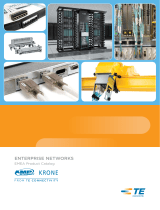Design Tools
The FiberRunner®Cable Routing System is offered with two different Design Tools that allow accurate system
drawings to be created which speeds overall system design, specification, and implementation. Both a VISIO* and
AutoCAD** version are available as free downloads from: www.panduit.com/products/selectiontools.
Panduit
®
FiberRunner
®
Cable Routing System Application Standards
FiberRunner®Design Tool for
AutoCAD** includes:
• Drag-and-drop functionality
• Ability to design in 2D or 3D
• Versions compatible with AutoCAD**
and AutoCAD** LT
• Automated BOM generator
Data Center VISIO* Layout
Tool includes:
• Drag-and-drop functionality
• Ability to design in 2D (stencils
for three different views are provided)
• Automated BOM generator
NEBS GR-63 CORE, Level 3 Compliance as tested by NTS
Network Equipment Building Systems (NEBS) was developed by
Bellcore, now know as Telcordia Technologies, and is currently
maintained by Telcordia Technologies. NEBS was developed to
standardize requirements for Central Office Equipment and to
develop criteria for personal safety, protection of property, and
operational continuity.
UL Underwriters Laboratories, Inc.
Underwriters Laboratories, Inc. is an independent, not for profit
safety testing and certification organization based in the
United States.
NEBS Level 3 Criteria is the minimum of environmental
compatibility needed to provide maximum assurance of
equipment operability within the network facility environment.
The Level 3 Criteria is the highest assurance of product operability.
Products that meet NEBS Level 3 Criteria are suited for equipment
applications, which demand minimal service interruptions over the
life span of the equipment. The Panduit®FiberRunner ®Cable
Routing System has successfully passed a range of tests including:
• Extreme Temperature and Humidity
• Operating Temperature and Humidity
• Zone 4 Earthquake and Office Vibration
• Needle Flame Analysis
UL 2024A Optical Fiber Cable Routing Assemblies
Covers, fittings and components construction, flammability rating
and marking. The FiberRunner®Cable Routing System has passed
test requirements for Riser Rated applications.
UL V-0 Flammability Rating
Underwriters Laboratories, Inc. Standards applicable to specified
Panduit ®FiberRunner ®Cable Routing System components.
TIA Telecommunications Industry Association
The Telecommunications Industry Association is a leading U.S.
non-profit trade association serving the communications and
information technology industry. TIA represents providers of
communications and information technology products and services
for the global marketplace through its core competencies in
standard development.
ANSI/TIA-942 Draft 5.0a – Telecommunications Infrastructure
Standard for Data Centers ANSI/TIA-569-B Commercial
Building Standard for Telecommunications Pathways
and Spaces
Referenced as a method of separating and routing data cable in
overhead cable routing applications. The Panduit®FiberRunner®
Cable Routing System provides pathway components that allow the
system to be configured in compliance with these standards.
15
*VISIO is a registered trademark of Microsoft Corporation in the United States
and/or other countries.
**AutoCAD is a registered trademark of Autodesk, Inc.





















